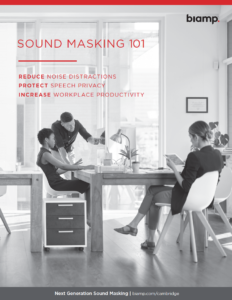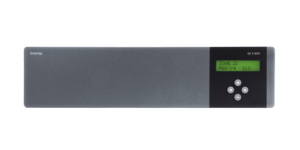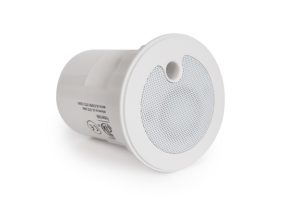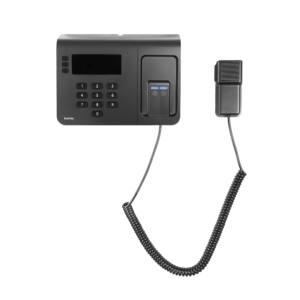FAQ
 Don’t know all there is to know about sound masking and speech privacy?
Don’t know all there is to know about sound masking and speech privacy?
Get the answers to the questions our team members are most often asked.
What is speech privacy?
Speech privacy is the inability of an unintentional listener to understand another person’s conversation. It is not practical to eliminate all conversational sounds in a workplace, but it is certainly not impossible to significantly reduce intelligible speech throughout a workplace. This is where our sound masking systems come into the picture.
Is this white noise?
No, but yes. Technically speaking, the sound frequency spectrum of our sound masking is different from white noise. This system is specifically engineered to contain the same spectrum as human speech. However, to the untrained ear, this system is the same as white noise. If someone is seeking a white noise system for their workspace, they are looking at the right product!
Is this noise cancellation?
No. Contrary to popular opinion, there is no “active noise cancellation” or “sound elimination” device on the market for large commercial spaces. These technologies exist for small, localized applications like headphones, but not for large commercial spaces. Cost considerations and the principles of physics prevent a large-scale noise cancelling system from being a viable option in any workspace.
For what applications is sound masking useful?
Sound masking can improve acoustical comfort in just about every industry and environment, but spaces that benefit the most include:
– Cubicles and Call Centers – reduce distractions and increase productivity
– Private offices – confidential speech privacy is desired
– Patient rooms – enhance patient comfort and privacy
– Libraries – reduce distractions caused by the lack of background noise.
– Lobbies – prevent overheard conversations from adjacent work areas
Does sound masking go in conference rooms?
Sometimes. Sound masking is more commonly installed outside of conference rooms to prevent people in the hallway (or adjacent space) from overhearing confidential conversations. The exceptions to this rule are if the sound proofing of the conference room walls is poor, or if the conference room doubles as a place for people to take tests or perform other activities requiring concentration. In that case, the conference room could have its own zone of sound masking and easily turn the system on/off as needed.
Will this system reduce server room noise?
No. Sound masking typically falls in the 40-48 decibel range. The sound is designed to blend into the workspace. A typical server room is upwards of 80 decibels, so it’s actually its own form of sound masking (although an irritating one for many)! If sound masking were added to a server room, the noise from the servers would actually cover the masking sound. A space like this can benefit from added sound absorption and increased acoustic isolation from surrounding wall and ceiling constructions, but not from sound masking.
Does this system have any effect on long-term hearing or loss?
No, this system has no negative impact on hearing or the human brain. Sound masking noise contains the same frequency content as the human voice making it no more harmful than a conversation. Additionally, sound masking systems operate at a very low level compared to decibel levels which cause hearing loss. The goal of sound masking is that people become oblivious to the system – and as a result, oblivious to the many distractions surrounding them in the workplace. There is no published material indicating that sound masking contributes to hearing loss.
My office is cold. Is there air coming from the sound masking system?
No, although the speakers emit an air conditioning-like “whooshing” sound, air does not flow from the system. The solution is simple – turn up the heat!
Why do I need four channels of sound masking?
A channel is a random noise sequence. If all of the sound masking emitters are playing the same sound, it is easy to get interference. Interference can occur at certain points when two identical signals are exactly out of phase, essentially causing noise cancellation. There might also be points where the identical signals are exactly in phase, creating an increase in sound level. This prevents sound uniformity as someone moves through the space. Cambridge Sound Management uses a four channel system to maximize not only the effective sound masking, but also ensure the comfort of occupants. With four channels, it is almost impossible to end up with adjacent speakers on the same channel therefore eliminating acoustical interference.
I can still hear others in my office. Is the system working correctly?
If you are in an open area, you may still hear activity noise around you, although they will be less noticeable with the sound masking turned on. For instance, with sound masking, you will not be able to hear the details of a conversation taking place 20 to 30 feet away.
Conversely, if you are in an enclosed office with sound masking turned on, you will not be able to hear conversations taking place outside your office. Private office privacy depends on both the level of isolation provided by office walls and ceilings and on the background noise.
Should I turn the system off at night?
Our systems require no maintenance and are designed to operate 24 hours per day on a continuous basis, 365 days per year. Our systems consume less than 4 watts of power per zone. Users can choose to utilize the day/night ramping feature on some control modules to reduce the systems’ volume level during night operations.
Do I have to reset the system if the power goes out?
No, it is not necessary to reset the system after a power outage. The control module is equipped with a non-volatile memory, so it will return to the correct volume level should power be interrupted.





